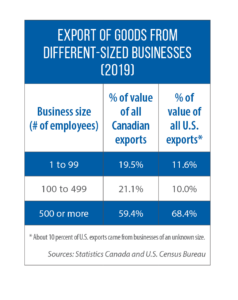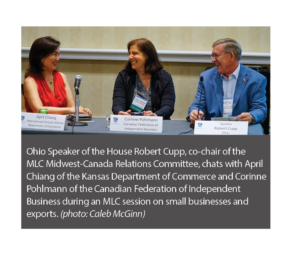Legislators learn how states, provinces can help small- and medium-sized businesses enter export markets
International trade and supply chains are often considered the domains of federal governments and multinational corporations.
After all, notable trade deals, including the United States-Mexico-Canada Agreement (USMCA or CUSMA in Canada), were negotiated largely at the national level, and often included input from large corporations in the automobile, technology and pharmaceutical industries.
However, there is space for small- and medium-sized enterprises (SMEs) — as well as states and provinces — to get involved.
 Policymakers learned how at the 76th Annual Meeting of the Midwestern Legislative Conference, during a session held by the MLC Midwest-Canada Relations Committee and led by two expert speakers: Corinne Pohlmann of the Canadian Federation of Independent Business and April Chiang of the Kansas Department of Commerce.
Policymakers learned how at the 76th Annual Meeting of the Midwestern Legislative Conference, during a session held by the MLC Midwest-Canada Relations Committee and led by two expert speakers: Corinne Pohlmann of the Canadian Federation of Independent Business and April Chiang of the Kansas Department of Commerce.
Pohlmann, whose nonprofit, nonpartisan association counts 95,000 small businesses as members, says a boost from export activity would be a much-needed antidote for some firms reeling from the effects of COVID-19.
According to a recent federation survey, 62 percent of small- and medium-sized firms in Canada reported pandemic debt, 78 percent still had not recovered form pandemic-related stress, and 54 percent has less-than-normal revenues.
Exporting is not for all businesses, Pohlmann said, but some that could expand to foreign markets report being hampered by a “lack of resources or expertise” or a “lack of appropriate contacts.”
State and provincial interventions can help overcome these obstacles, including getting SMEs engaged in the vast (and potentially lucrative) Canada-U.S. supply chain.
One example of this kind of assistance: the Saskatchewan Trade and Export Partnership.
Funded by the province but run as a nonprofit with businesses themselves on the board, the program provides funding to Saskatchewan firms looking to access foreign markets. It also offers education, training, trade missions and customized advice.
Chiang said the Kansas Department of Commerce’s International Division (where she works) has three main export-assistance functions: educate, promote and recognize Kansas enterprises.
The education component is done through webinars, company visits and customizes counseling. Promotion may be of most interest to SMEs, and that is done through state grant programs.
The State Trade Expansion Program (funded by the U.S. Small Business Administration, administered by the state Department of Commerce) offers export-focused training, assistance with market entry, and trade missions and shows. Other grants reimburse business for participation in trade shows or export-related marketing.
The state also administers a Kansas Governor’s Exporter of the Year Award.
 For policymakers on both sides of the border, Pohlmann had these ideas to help open markets for SMEs:
For policymakers on both sides of the border, Pohlmann had these ideas to help open markets for SMEs:
- improve and clarify the rules on labor mobility;
- expand the role of sub-national governments in U.S.-Canada trade and regulatory discussions;
- provide more guidance to SMEs on how “rules of origin” regulations work under the USMCA, and make these rules easier to understand;
- reduce non-tariff administrative burdens; and
- improve how government agencies interact with businesses and distribute information on issues related to international trade.